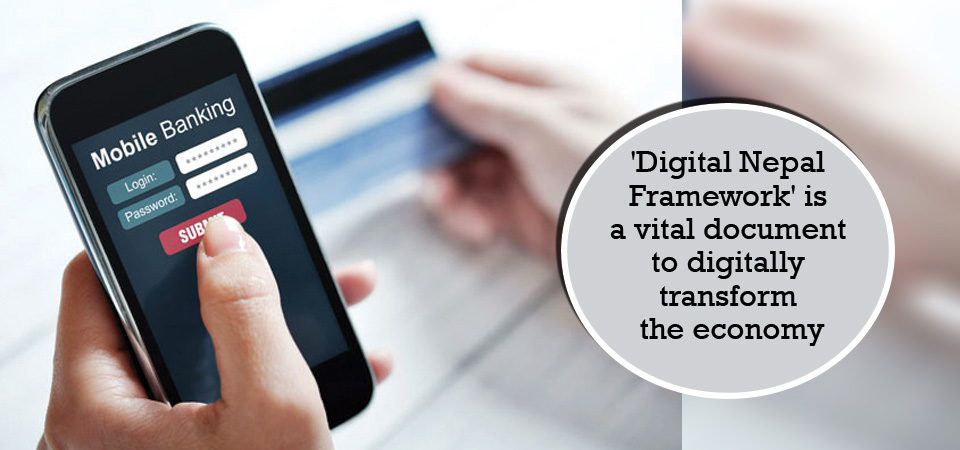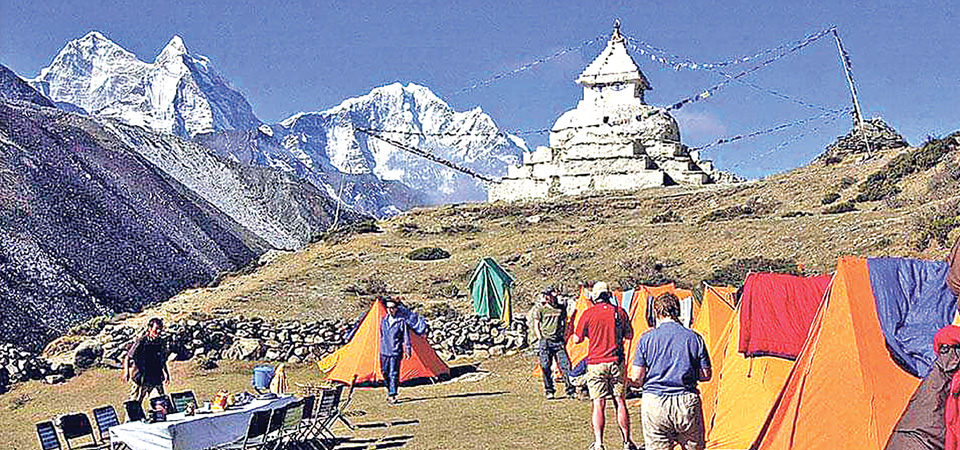During COVID-19
Digitalisation Of Financial Sector

Juhi Adhikari
With the shift of the demographics from offline to online methods and with the increased use of technologies, there has been a significant push for digitalisation of everyday life such as ordering groceries, shopping, education, etc.
When people use more online platforms for things they need, they also need digital payment systems to make it easier. This push affects all industries equally and demands significant measures to comply with infrastructure and regulatory requirements to ensure no loose ends that could end up harming the system.
Keeping up with the change in trends, the Nepali financial sector was adopting digital technologies before the pandemic too, but the crisis has brought digital banking into focus. The transition from SMS to the internet and now to Mobile and Online Banking clearly shows how the financial sector has transformed.
Let us focus our attention on understanding how the digitisation process is taking place in the finance sector of the country and how the process has changed during the COVID-19 pandemic period.
Digitalisation Evolution
Finance is the major sector influenced by digitalisation and digital technologies by leading the fundamental changes in society. The emergence of online banking, digital media, ATM cards, digital payments, and wallets has reconstructed the general way of performing business and supplemented the traditional businesses. The American Scientific Research Journal for Engineering, Technology and Sciences defines "Digitalisation is the phenomenon of transforming analogue data into the digital language (i.e. digitisation), which, in turn, can improve business relationships between customers and companies, bringing added value to the whole economy and society".
The oversight report of Nepal Rastra Bank shows the success of digitisation in Nepal. Debit card users increased by 9.25 per cent in 2020 as compared to 2019. Credit card users increased by 30.17 per cent in 2020 as compared to 2019. Prepaid card users decreased by 5.36 per cent in 2020 as compared to 2019. The total number of ATMs increased by 23.82 per cent in 2020 compared to 2019. In the Year 2019/20, the number of mobile banking users increased by 35.46 per cent and reached 11,306,797.
Similarly, the number of internet banking users increased by 12.41 per cent and reached a staggering 1,031,227. All these figures represent the readiness of the population to shift to new online methods and adapt to the digitalisation process. Such a drastic shift from traditional means of business and transactions brings along a range of positive and negative outcomes.
The adoption of technology in the banking industry began after the introduction of telecommunications into the banking market in 1846 globally. Nabil Bank in the 1990s introduced the first credit cards, which took more than fifty years since the establishment of the first commercial bank, Nepal Bank Limited, in 1937 in Nepal. Then, it took another 15 years to start E-banking which was started by Kumari Bank in 2002. The Himalayan Bank is leading in terms of Automated Teller Machine (ATM).
All these new digital services including ATMs, Debit/Credit cards, and online banking almost replaced most of the manual and hand-writing-based financial transactions. The 'Digital Nepal Framework' is a vital document to digitally transform the economy and make an exceptional effort to adopt the new means of business and operations from 2018 as per the Ministry of communication and Information Technology.
This framework has divided Nepal's economy into eight major domains: Agriculture, Health, Education, Tourism, Energy, Financial Services, Connectivity, and Urban Infrastructure. Digitalisation in the finance sector is core for implementing the framework. With strong backing from the continuous penetration of mobile and internet in the country as seen by the year-on-year rise in the numbers of users, the country realized the need of the hour i.e. to develop digital payment and banking services.
All major banks are competing to provide online as well as mobile wallets services. Some private mobile wallet companies like the 'E-Sewa' by fintech startup 'F1 Soft' have proved a milestone in the country's journey towards digitalisation since 2009. Following the trend, other applications like 'Khalti' and 'FonePay' have further helped strengthen this initiative. The 'Connect IPS' system implemented by the Nepal Clearing House is fully functional to clear the government-related payments and transfers.
Other than banks, digitalisation in other domains such as investment banking, investments, real estate, mortgage lending have all reaped the benefit of this shift in the form of increased customer base, better operations handling, future predictions, and advanced analytics for better business services. Recently, there has been an introduction of 'Automated Wealth managers capable of investing your money on your behalf in the best of schemes based on rigorous calculations, all thanks to their AI (artificial intelligence) software.
Merits And Demerits
With the onset of the pandemic in 2020, there has been a realisation of the importance of a digital system that can be used by the public in general as stepping out of homes involves a lot of risks. This came as a blessing in disguise for a country that saw better digital banking adoption rates in both rural and urban areas than ever before. The report published in the Journal of Science, technology, and management states that during the COVID-19 pandemic, people preferred digital payments compared to cash as 57% of people believed that cash could spread the virus.
People have accepted the new normal and have entrusted the mobile wallet applications as a new method of payment. This acceptance can be seen by the increase in the number of users of the available applications. E-Sewa saw a staggering 35% rise in its number of users bringing its user base to a massive 3.5 million users. IME pay, another mobile wallet app, added nearly 25% of their users as new registrations with more than 60% of the users from semi-urban and rural parts of the country. With more and more people getting on board and adopting the digital shift of the economy, it's only a matter of time for the achievement of the goals set by the 'Digital Nepal Framework'.
SBI Bank has taken a huge step towards digitalisation by opening the Nepal SBI InTouch outlet at Durbar Marg, Kathmandu which is AI-based. The InTouch outlet not only provides alternate channels to customers for banking but also helps in making paperless banking a reality. They provide various auxiliary services such as Indian railway ticket booking, and utility payments. Out of the many advantages of the digitisation process, some are important and noteworthy.
First, with businesses being conducted online, there has been a significant improvement in the ease of doing business as there is now no time restriction to undertake transactions. Even in the morning and evening time, business enterprises, as well as individuals, can do financial transactions through banking channels. The second advantage is more related to the management of currencies. The shift towards the digital economy is for good as it reduces the pressure on the paper currency being circulated in the economy hence, saving the expenses of Nepal Rastra Bank. The third advantage, the digitalisation of the finance sector is contributing to better customer satisfaction.
We used to hear a lot of customers' complaints regarding delays, human errors, long waiting hours, and paperwork. After the increasing digitalisation, the complaints about those issues have been minimised. We can note the fourth advantage as the time and cost savings in many ways. People do not have to travel out and spend hours on safe and banking transactions. It also saves costs of travel expenses, paper documentation, time of human resources, and many more.
This time-saving merit can contribute to making people more productive in other works. Another huge benefit is making the financial transaction contactless. During this time of pandemic and also in the time of strict restriction to mitigate the effects of COVID-19, the digital transactions have contributed a lot for social distancing and helping to mitigate COVID-19 spread. Finally, the digitalisation of the finance sector has also contributed to mental safety. We don't need to keep large sums of money in our homes. That also reduces the risk of theft and burglary of cash currencies.
Alongside advantages, there are some disadvantages as well. With a rise in online payment systems and online business, the important demerit is a lack of equal infrastructure development, errors such as server downtime are common sightings on the portals. Second, security risks like hacking and personal information leaks/theft have significantly increased, leading to erosion of trust for the customers pursuing online banking. Similarly, transforming the whole industry that has been operating offline for the majority of the time requires massive outlays and investments that may not be feasible for many business houses.
We should note that we don't have reliable broadband internet in all parts of the country, which can make many people not have access to digital services. Similarly, we should not forget that many people are less literate, it's difficult to use online services for them. Even though in the case of more literate people, the majority of people are good at Nepali but most of the digital banking services are in English.
So language is a greater barrier and challenge. For many such less literate and less English users, access to digital services makes higher risks of misuse of their digital accounts by someone else's mistakes. The important point is not only about having access or having the services, the important point would be whether we have strong data safety and user-friendly features or not.
Relevance
Digitalisation brings with itself a myriad of benefits for its customers ranging from ease of transactions and better control. The digital transformation and integration of the digital world affected an array of ways the economy operates and undertakes processes. The first and foremost is the ease of undertaking transactions from the comfort of your home or any place for that matter with a stable internet connection. Gone are the days when one used to head to the bank and physically make transactions. With all the information now available at the click of a button, it has been significantly easier to have better control over the finances.
The digital Nepal framework initiative taken by the government and the efforts by the banks in terms of launching apps, digital wallets, and comfort during pandemic times are reasons to attract customers. The rapid growth of card users and online transactions depicts the readiness of the people to adopt these methods and be in line with the digital wave the country is experiencing.
With proper government action plans and policies, there can be drastic changes brought to the economy and the public as a whole in terms of efficiency, global recognition, and steps towards a cashless economy. With the push that the economy currently has towards digitalisation and its adoption supplemented by the changing demographics and the rise in mobile and internet penetration in the country, fueled by the government's 'Digital Nepal Framework', the country will surely achieve its defined goals and objectives. With the respective framework in place, combined with the payment gateway and mobile applications, true integration of the economy with Fintech has taken the economy up in excitement and enthusiasm.
(Juhi is a freelance writer and digitisation research assistant)
Recent News

Do not make expressions casting dout on election: EC
14 Apr, 2022
CM Bhatta says may New Year 2079 BS inspire positive thinking
14 Apr, 2022
Three new cases, 44 recoveries in 24 hours
14 Apr, 2022
689 climbers of 84 teams so far acquire permits for climbing various peaks this spring season
14 Apr, 2022
How the rising cost of living crisis is impacting Nepal
14 Apr, 2022
US military confirms an interstellar meteor collided with Earth
14 Apr, 2022
Valneva Covid vaccine approved for use in UK
14 Apr, 2022
Chair Prachanda highlights need of unity among Maoist, Communist forces
14 Apr, 2022
Ranbir Kapoor and Alia Bhatt: Bollywood toasts star couple on wedding
14 Apr, 2022
President Bhandari confers decorations (Photo Feature)
14 Apr, 2022




